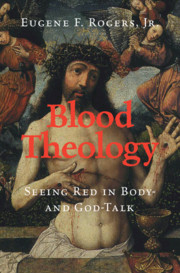Book contents
- Blood Theology
- Reviews
- Blood Theology
- Copyright page
- Dedication
- Contents
- Acknowledgments
- Part I Why We See Red
- Part II Blood Seeps in Where It Hardly Seems to Belong
- 2 Blood after Isaac
- 3 Blood after Leviticus
- 4 Blood after the Last Supper
- Part III Blood Makes a Language in Which to Conduct Disputes
- Part IV The Blood of God at the Heart of Things
- Appendix Review of Gil Anidjar’s Blood: A Critique of Christianity
- Sources Cited or Consulted
- Scripture Index
- Subject Index
3 - Blood after Leviticus
Separation and Sacrifice
from Part II - Blood Seeps in Where It Hardly Seems to Belong
Published online by Cambridge University Press: 22 March 2021
- Blood Theology
- Reviews
- Blood Theology
- Copyright page
- Dedication
- Contents
- Acknowledgments
- Part I Why We See Red
- Part II Blood Seeps in Where It Hardly Seems to Belong
- 2 Blood after Isaac
- 3 Blood after Leviticus
- 4 Blood after the Last Supper
- Part III Blood Makes a Language in Which to Conduct Disputes
- Part IV The Blood of God at the Heart of Things
- Appendix Review of Gil Anidjar’s Blood: A Critique of Christianity
- Sources Cited or Consulted
- Scripture Index
- Subject Index
Summary
“Blood after Leviticus” observes there is initially not “enough” blood in Leviticus, which only “daubs” or “sprinkles” it, with the rest poured on the ground, removed from cultic use. The reinterpretation of Leviticus in the New Testament book of Hebrews imagines much more. Leviticus’ reception history shows how drops of blood become floods in imagination: Blood burgeons at need. The chapter includes accounts of Christian animal sacrifice at sites of St. George in the West Bank and Samaritan animal sacrifice at passover. It reflects on tropes of infinite blood.
- Type
- Chapter
- Information
- Blood TheologySeeing Red in Body- and God-Talk, pp. 51 - 82Publisher: Cambridge University PressPrint publication year: 2021

